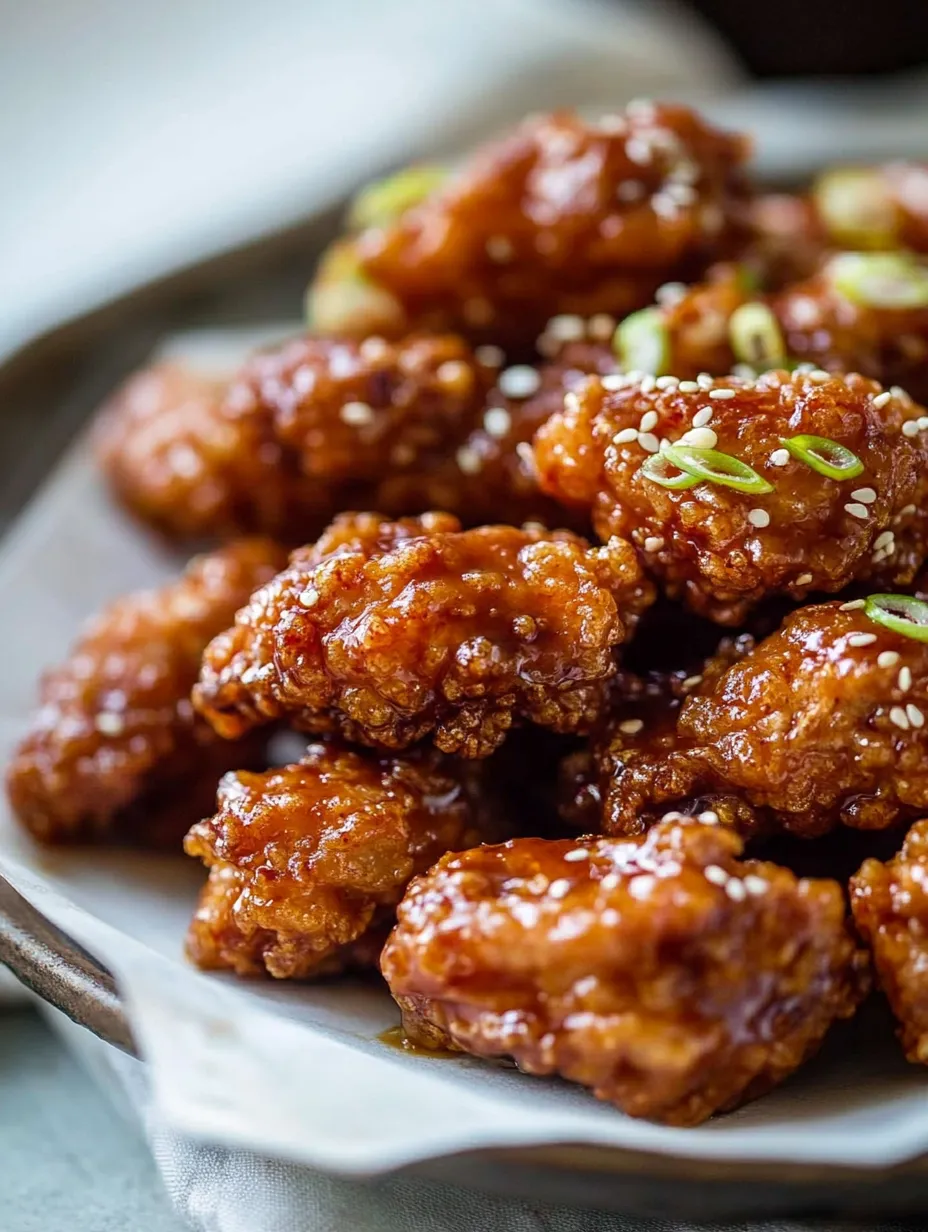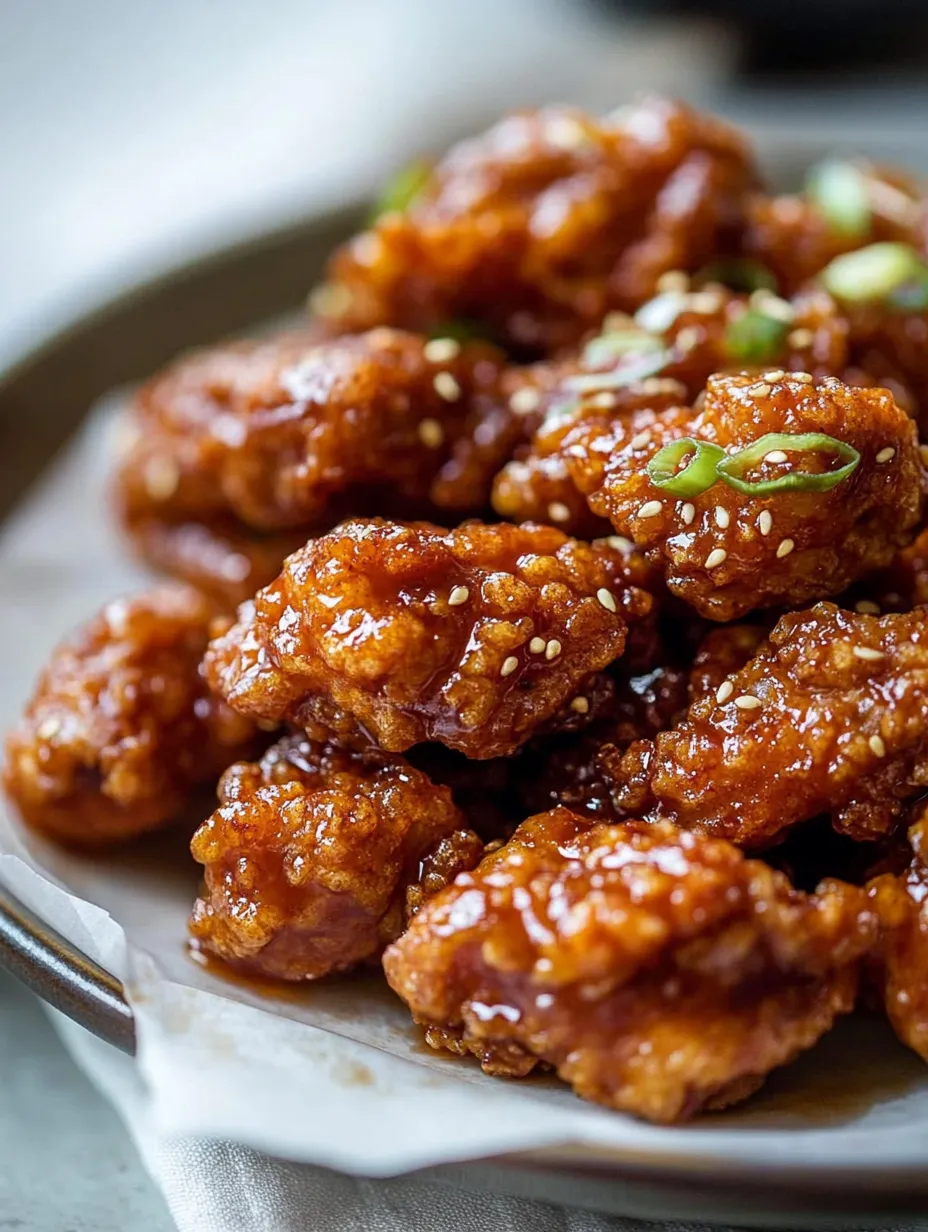 Save
Save
The first time I tried Dakgangjeong, I was hooked instantly – the crunch of perfectly fried chicken paired with a glossy, sticky glaze that danced between sweet and spicy felt like discovering a hidden treasure in Korean cuisine. It reminded me of late-night street markets in Seoul, where every bite bursts with flavor and excitement. Since then, this recipe has become my go-to for quick gatherings that demand something both comforting and unforgettable.
I first stumbled upon this technique from a Korean friend who swore by soaking chicken in milk or rice wine to keep it tender while you achieve that crispy crust. It was a revelation – juicy inside, crisp outside, and a glaze that clings perfectly without losing its crunch.
Essential Ingredients
- Boneless skinless chicken thigh/breast: thighs offer richer flavor and tenderness; breast leans leaner but can dry out faster
- Milk (optional): tenderizes the chicken subtly; if skipped, rice wine works as an acid and flavor enhancer
- Potato starch (or corn starch): creates the signature light, crunchy crust; potato starch tends to give a crispier finish
- Gochujang (Korean red chili paste): the heart of the sauce’s heat and umami; adjust for spice tolerance or substitute with mild chili paste
- Honey or rice syrup: adds sticky sweetness; honey brings floral notes, syrups create shine and texture
- Apple cider or rice vinegar: brightens the sauce and cuts through sweetness for balance
- Sesame oil: a finishing touch that lifts aroma and rounds out flavors
Shopping tip: Look for freshly ground or vibrant gochujang in Asian markets, and check syrup labels closely if using alternatives to honey to avoid overpowering sweetness. Fresh ginger and garlic should be firm and unblemished for maximum punch.
Cooking Process
- Preparing the Chicken:
- Trim and cut into bite-sized pieces for even frying and serving ease; soaking in milk or rice wine tenderizes, gives depth
- Marinating:
- Season with salt, pepper, minced garlic, and ginger; resting lets flavors seep in gently
- Crafting the Sauce:
- Combine soy sauce, mirim, vinegar, gochujang, honey, brown sugar, and aromatics, simmer to meld and thicken just right
- Coating with Starch:
- Each piece gets an even dusting for that iconic sheer crunch; don’t skimp or it won’t hold crispness
- The Double Fry:
- Fry at 330°F the first time to cook chicken gently and form a base crust; rest then fry again to golden perfection and durable crisp
- The Glazing Finale:
- Toss chicken in warm sauce over low heat for sticky coating that clings but stays crisp
- Serving:
- Scatter chopped peanuts or seeds for extra texture and a nutty finish

Recipe Highlights
- High protein, balanced by minimal breading and a moderate amount of sugar in sauce
- Quick to make, especially with boneless bites, great for parties or snacks
- Customizable heat level—gochujang can be omitted or boosted to suit any palate
One time, I rushed the double frying step and ended up with soggy chicken that soaked up too much oil. That taught me patience is everything here—low and slow the first round, hot and quick the second, for that unbeatable crunch that doesn’t cave under the glaze.
Make-ahead strategies
You can prep the chicken and marinate it the night before, then fry fresh when guests arrive. The sauce also keeps well refrigerated and can be gently reheated without losing vibrancy. For a party, fry the chicken entirely, keep warm in a low oven, and toss with sauce just before serving.
Flavor variations
Swap honey for brown sugar and a splash of orange juice for a citrus twist. Add toasted sesame seeds atop for nuttiness, or stir in minced fresh chilis for an extra kick. For a mild version, skip gochujang and add extra soy sauce and a dash of smoked paprika to mimic warmth without heat.
Kitchen tool recommendations
A narrow, heavy-bottomed deep pan or a wok holds oil temperature better for frying. Use a candy or deep-fry thermometer to maintain a steady 330°F for both frying rounds. A wire rack is essential to drain excess oil and keep the crust crisp.
Cooking Secrets
- Soaking chicken pieces in milk or rice wine keeps the meat tender, balancing the double-fry crispiness perfectly.
- Don’t crowd the pan during frying to avoid drastic temperature drops that cause greasy, soggy pieces.
- Toss chicken in warm sauce over gentle heat; too hot will dissolve the crisp crust, too cool won’t coat evenly.

Frequently Asked Recipe Questions
- → What type of chicken works best for this dish?
Boneless skinless chicken thighs or breasts are ideal as they cook quickly and stay tender.
- → Why is the chicken double-fried?
Double frying creates a crunchier exterior by removing excess moisture and reinforcing crispiness.
- → Can I adjust the spice level of the sauce?
Yes, reduce or omit the chili paste to make it milder, or add more for extra heat.
- → What is the purpose of soaking the chicken in milk?
Soaking helps tenderize the chicken and can mellow flavors, though it’s optional.
- → What starch is best for coating the chicken?
Potato starch or corn starch both provide a light, crisp coating after frying.
- → How should the sauce be prepared for optimal flavor?
The sauce ingredients should be simmered gently until slightly thickened to concentrate the flavors before coating the chicken.
